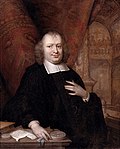William III of England
William III and II (4 November 1650 – 8 March 1702) was King of England and Ireland from 13 February 1689 (as William III) and he was king of Scotland from 11 April 1689 (as William II). He remained king until his death on 8 April 1702.
| William III and II | |
|---|---|
 Portrait by Sir Godfrey Kneller, 1680s | |
| King of England, Scotland, and Ireland (more ...) | |
| 1689[a] – 8 March 1702 | |
| 11 April 1689 | |
| Predecessor | James II & VII |
| Successor | Anne |
| Co-monarch | Mary II |
| Stadtholder of Holland, Zeeland, Utrecht, Guelders, and Overijssel | |
| 4 July 1672 – 8 March 1702 | |
| Predecessor | William II |
| Successor | Second Stadtholderless period |
| Prince of Orange | |
| 4 November 1650[b] – 8 March 1702 | |
| Predecessor | William II |
| Successor | John William Friso (titular) |
| Born | 4 November 1650 [NS: 14 November 1650][b] Binnenhof, The Hague, Dutch Republic |
| Died | 8 March 1702 (aged 51) [NS: 19 March 1702] Kensington Palace, Middlesex, Kingdom of England |
| Burial | 12 April 1702 Westminster Abbey, London |
| Spouse | |
| House | |
| Father | William II, Prince of Orange |
| Mother | Mary, Princess Royal |
| Religion | Protestant |
| Signature |  |
William was born in the Netherlands as Prince William Henry of Orange. His mother was Mary Stuart. Mary was the sister of the King of England, James II, so King James was William's uncle. William married King James's daughter Mary (his own first cousin) on 4 November 1677.
The Protestant majority in England did not like King James, and he was overthrown in the "Glorious Revolution" of 1688. William landed in England (at Brixham) with a Dutch army. When William landed, James's support melted away. James was allowed to leave for France, and William became the last person to successfully invade England by force.
The English Parliament offered the English crown to William and Mary jointly (and when one died the other would be monarch), making them William III and Mary II. This later came to be known as the reign of William and Mary. Laws were passed which protected Parliament from unreasonable acts of the Sovereign, guaranteed religious toleration to Protestant nonconformists, but restricted the religious liberty of Roman Catholics and non-Christian faiths.
William summoned a Convention of the Estates of Scotland in 1689 and sent them a conciliatory (~friendly) letter, unlike James, who had tried to give them orders. On 11 April, the day of the English coronation, the Convention finally declared that James was no longer King of Scotland. William and Mary were offered the Scottish crown, and they accepted on 11 May. The Jacobites tried for over 50 years to have James and his heirs reinstalled.
William's enemy was the King of France, Louis XIV, who protected and supported James in his efforts to return. In Ireland, the majority Roman Catholics were reinforced by French forces led by Jacobites. William personally led his army to victory at the Battle of the Boyne in 1690. James fled back to France.
There was next a Nine Years' War between a coalition led by William, and France. The Anglo-Dutch Alliance did well on sea and defeated a French fleet at La Hogue in 1692. On the other hand, the alliance lost Namur in 1692, and the Battle of Landen on land, in 1693.
Mary died on 12 December 1694 of smallpox, leaving William to rule alone. He was eventually succeeded by his sister-in-law, Queen Anne. One more fact is of great importance. In 1701 an Act of Parliament was passed which settled the succession of the thrones of England and Ireland on Protestants only. Scotland was not part of this arrangement until the parliamentary union of the two kingdoms in 1707.
William III Of England Media
Gaspar Fagel replaced de Witt as grand pensionary, and was more friendly to William's interests.
Recapture of Naarden by William of Orange in 1673
The thanksgiving service of William's army in Grave after its capture
Hendrik Overkirk saves William of Orange from a French dragoon at the Battle of Saint-Denis, by Jacob de Vos
References
- Notes
- ↑ William was declared King by the Parliament of England on 13 February 1689 and by the Parliament of Scotland on 11 April 1689.
- ↑ 2.0 2.1 During William's lifetime, two calendars were in use in Europe: the Old Style Julian calendar in Britain and parts of Northern and Eastern Europe, and the New Style Gregorian calendar elsewhere, including William's birthplace in the Netherlands. At the time of William's birth, Gregorian dates were ten days ahead of Julian dates: thus William was born on 14 November 1650 by Gregorian reckoning, but on 4 November 1650 by Julian reckoning. At William's death, Gregorian dates were eleven days ahead of Julian dates. He died on 19 March 1702 by the Gregorian calendar, and on 8 March 1702 by the standard Julian calendar. (However, the English New Year fell on 25 March, so by English reckoning of the time, William died on 8 March 1701.) Unless otherwise noted, dates in this article follow the Julian calendar with New Year falling on 1 January.
Other websites
- William III (Britain) Archived 2016-03-05 at the Wayback Machine Citizendium







